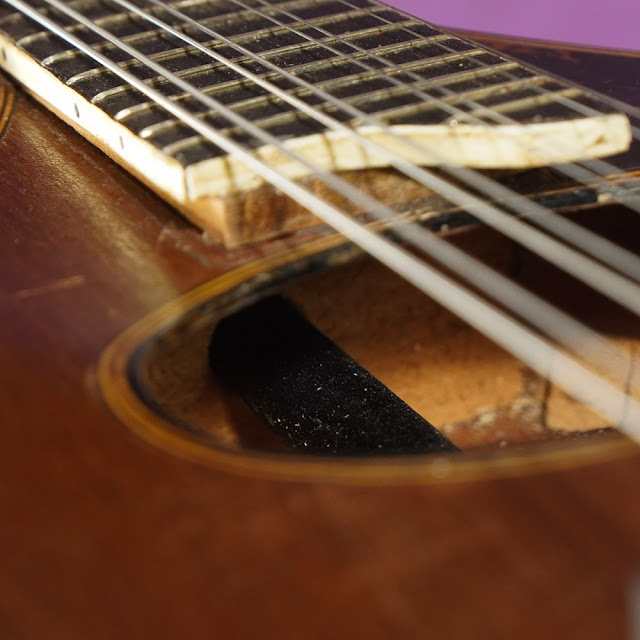1920s Regal-made Mahogany Flatback Mandolin
Overview: This mandolin has lived a rough life! It's also now had all sorts of modifications and is definitely something it wasn't when it was made -- in a sense, anyhow. This same model of instrument wears many brands (Regal, Washburn, Lyon & Healy, among others) but was made in the Regal factory in the mid-'20s. It's a pretty thing, with multi-ply binding, covered tuners, and an inlaid celluloid pickguard. It's also got a nice, woody, sweet sound.
Repairs included: These mandolins often have failing neckblocks (where the neck caves into the body because it was underbuilt when new) and our standard repair, these days, is to fit an internal 1/2" dowel from endblock to neckblock on this style of mandolin. This has been done. At the same time, the neck got a reset (though the angle was set quite steep) and the fretboard extension got wedged-up to suit. The two main braces were replaced with heavier-duty ones and hairline cracks on the bass side of the top got cleating/patches to stabilize them. The frets got a level/dress, it's had an adjustable bridge fit, and it's setup and ready to go.
- Weight: 1 lb 5 oz
- Scale length: 12 7/8"
- Nut width: 1 1/8"
- Neck shape: medium soft V
- Board radius: flat
- Depth at first fret: 27/32"
- Depth at seventh fret: 59/64"
- Body width: 9 3/8"
- Body depth: 2 1/4"
- Top wood: solid mahogany
- Back & sides wood: solid mahogany
- Bracing type: ladder
- Bridge: adjustable rosewood
- Fretboard: ebonized maple/pearwood
- Neck wood: mahogany
- Action height at 12th fret: 1/16" overall (fast, spot-on)
- String gauges: 32w-9 extra light (Dogal)
- Neck relief: straight
- Fret style: low/small
Condition notes: There are light scuffs and scratches here and there throughout. The ebonized-maple fretboard shows some color leaching and a few small repaired spots from chip-out at the fret tangs. There's a little discoloration/grunge at the neck joint itself. Obviously, a dowel has been added internally. The top bracing has been modified and, as such, the top is a little flatter than it was when it was originally built. The bridge is unoriginal. There are repaired hairline cracks on the bass side of the top near the soundhole. There's a little "bulge up" to the top just before the tailpiece -- this is common on about 1/3 of these instruments as they age as there's very little bracing in that area and so they "compact" a bit there. The dowel we added stabilizes against this problem.
It comes with: Sorry, no case.
Consignor tag: JW


















Comments